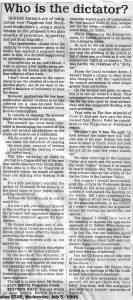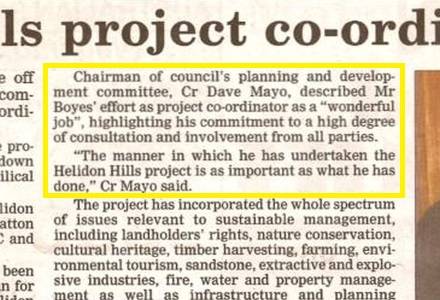
The “Intellectual Dark Web” is nothing new, but highlights a critical issue
This article is part of a series of articles on stakeholder and community engagement.
On May 8, the New York Times published an opinion piece by Bari Weiss introducing the “Renegades of the Intellectual Dark Web.” Weiss describes the Intellectual Dark Web (IDW) as:
a collection of iconoclastic thinkers, academic renegades and media personalities who are having a rolling conversation — on podcasts, YouTube and Twitter, and in sold-out auditoriums — that sound unlike anything else happening, at least publicly, in the culture right now. Feeling largely locked out of legacy outlets, they are rapidly building their own mass media channels.
The closest thing to a phone book for the I.D.W. is a sleek website that lists the dramatis personae of the network
The people listed on the IDW website include:
- Jordan Peterson, professor of psychology at the University of Toronto and critic of political correctness
- Sam Harris, neuroscientist and critic of religion
- Ayaan Hirsi Ali, academic fellow, feminist, and critic of Islam
- Bret Weinstein and Heather Heying, former professors at Evergreen State College who resigned after being labeled as racist for their opposition to a “Day of Absence” where white students had been asked to leave the campus for a day
- Eric Weinstein, brother of Bret Weinstein and the person who coined the term “intellectual dark web”
- Dave Rubin, political commentator, comedian, and talk show host who opposes the “regressive left”, a term which he and others use to describe left-leaning people who are tolerant of Islam
- Ben Shapiro, formerly editor-at-large of the far-right Breitbart news service, and a conservative who accuses liberals of using cinema and TV to push an identity politics agenda
- Christina Hoff Sommers, a feminist who is critical of modern feminism, arguing that modern feminist thought often contains an irrational hostility to men
- Maajid Nawaz, a former Islamist who has renounced Islamist extremism.
Weiss’ opinion piece has triggered a strong reaction in the mainstream media and on social media, with a wide spectrum of views expressed. For example, on the one hand, a follow-on opinion piece by Michelle Goldberg, also in the New York Times, offers a degree of sympathy for the IDW perspective, arguing that the approach of the online left fuels resentment in the right. On the other hand, Cristina López G., a senior researcher at Media Matters, draws on a long list of Tweets from other journalists to slam Weiss’ opinion piece as being “just plain bigoted”:
In a May 8 column that lionized the members of the so-called “intellectual dark web,” New York Times opinion columnist Bari Weiss misled her audience by portraying commentators known for inflammatory rhetoric about oppressed minorities as intellectuals exiled into the “dark web,” a name for the hard-to-reach areas of the internet. The cast of characters she profiled is far from being exiled to the dark web. In fact, they profit from broadcasting bigoted ideas on platforms that reach massive audiences.
So, is Bari Weiss’ opinion piece raising important and valid issues in regard to public discourse, or is it “just plain bigoted”?
Back to the future
In her opinion piece, Weiss contends that “A decade ago … none of … [the IDW] observations would have been considered taboo,” and that the rise of the IDW is in response to our entry into a “new era of That Which Cannot Be Said”.
However, my immediate reaction upon reading the opinion piece was to feel more than a little like Marty McFly when he was suddenly thrown back in time in the movie Back to the Future. This is because I first encountered what Weiss describes as the IDW in the late 1990s, in the form of the Inverell Forum. I had became aware of the Inverell Forum while working at Gatton Shire Council, which as can be seen from the 1999 Forum notes had been the target of a judicial review campaign by Forum participant Dennis Zammit.
As with the current IDW, the Inverell Forum featured speakers addressing a range of controversial and taboo issues. This included academics with controversial views such as Associate Professor Drew Fraser, who has publicly spoken out against immigration and multiracialism, and the late Professor Bob Carter, a climate science denialist. Carter and controversial anti-immigration and anti-Islam politician Pauline Hanson withdrew from the 2007 forum amid controversy. Macquarie University suspended Fraser in 2005, and James Cook University dumped Carter in 2013. The IDW in Australia has also always included media personalities, in particular “shock jock” radio commentators like Alan Jones.
A darker influence
In an approach described as typical of the dark web, nobody knows who made the IDW website. But even darker than this, and darker than the Inverell Forum, is an organisation whose secretive members have been closely associated with Inverell Forum. This organisation is the Australian League of Rights.
As an Australian Government Human Rights and Equal Opportunity Commission report states (p. 200):
The League of Rights is undoubtedly the most influential and effective, as well as the best organised and most substantially financed, racist organisation in Australia. Its resources, influence, stability and professionalism far exceed those of any other racist organisation in Australia, past or present. In part its success is due to the relative subtlety with which its racist ideology is promoted. Those disturbed by the activities of the League have alluded to the fact that many of its members have sought election to Parliament or appointment to influential government positions without revealing their connections with the organisation.
The League of Rights was exposed trying to use its dark influence to manipulate the National Party of Australia in 1988 (the same year that the Inverell Forum was established). National Party Senator Ron Boswell subsequently launched a campaign against the League of Rights and their ideas, which he continued into the following year.
I also have personal experience of the dark influence of the League of Rights, as a direct target of it. In 2001-2002 I worked as Natural Resource Management Project Officer for Crow’s Nest Shire Council, which was located directly northwest of Gatton Shire Council where I’d previously worked. The League of Rights had a significant presence in the area, as evidenced by their January 2001 Australia Day meeting and May 2001 Queensland State Weekend events at the Highfields Cultural Centre, which was located in Crow’s Nest Shire. The Queensland State Weekend included two speakers who put forward conspiracy theories in regard to Australia’s horrific Port Arthur massacre, which led to the introduction of strict gun control laws.
While working at Crow’s Nest Shire Council, I arranged to rent a cottage in a small alternative lifestyle community. Soon after I had moved in, the husband of the owner of the cottage invited me to visit their nearby house for drinks. It was daylight when I arrived so the husband, Dr Pat O’Neil, showed me a number of small cabins that he had built on their property. He said that these were intended as safe refuges for family and friends should the state capital city of Brisbane be invaded by foreign forces. This certainly raised my eyebrows, and then later, while sitting in their living room drinking his home brew, he started asking me strange conspiracy theory-related questions. Starting to feel quite concerned, I noticed a document on a corner table on the other side of the living room that appeared to have the distinctive League of Rights logo on it. When he stepped out of the room to get another bottle of home brew, I quickly took a closer look at the document. My heart sank when I saw that it was a copy of On Target, the League of Rights newsletter.
Escaping the darkness
Following this realisation, I had to take drastic action to escape the situation because I could have been labelled a League of Rights sympathizer or stooge, putting at risk both my reputation and that of my employer, Crow’s Nest Shire Council. Fortunately the cottage rental was a week-to-week arrangement rather than a lease, so I moved out of the cottage a few days later, making excuses about it being unsuitable. A 1994 Canberra Times opinion piece highlights the dangers of being seen to be linked to groups like the League of Rights. I would later notice that Dr Pat O’Neil had also spoken at the 2001 Inverell Forum.
However, despite having to take the urgent action to leave, I could not describe Dr Pat O’Neil as a bad person. Rather, he struck me as an ordinary everyday person who was highly suspicious of the mainstream political establishment and mainstream media because he felt isolated and ignored by them.
I could relate to this perspective, because in 1995, I’d had my own direct experience with the mainstream political establishment and mainstream media rejecting genuine community concerns, as shown in the following letter to the editor and editorial.

The draft Gatton Shire Planning Scheme had proposed a “stick” approach to achieving environmental outcomes that didn’t consider the need of rural landholders to make a living from their land. I had proposed a different approach, based on the planning scheme measures that I had seen nearby Ipswich City Council develop for heritage protection while I was a member of the Ipswich City Council Heritage Advisory Committee from 1991 to 1994. Those measures respected landholder property rights by allowing innovate options for listed heritage properties. As a result, when Ipswich City Council notified property owners across the city of Council’s intention to include their properties in the heritage register, not only was there 100% acceptance, but there were a number of property owners whose properties hadn’t been identified in the heritage study who wanted them to be listed. These were assessed and found to also be worthy of inclusion.
Gatton Shire Council would later employ me to develop and implement the measures1 that were rejected in the above editorial. These measures have worked very well and are still in place.
This experience with the mainstream political establishment and mainstream media rejecting genuine community concerns also influenced the perspective I took in regard to a vineforest conservation project that I carried out soon after the above editorial. In the project report2, I state that (p. 10):
Unfortunately, the strong left-wing social agenda that has become entwined into the agenda of the environmental movement in Australia has to date been actively working against incentive based solutions, teaching as it does that the only way to save the planet is to completely abandon the consumer economy. This dual agenda is actually undermining conservation efforts in Australia, as conservation measures imposed without any consideration for the landholder just result in a backlash against conservation. Governments then end up being forced to bury what had appeared to be solid gains for conservation.
That perspective is echoed in the follow-on opinion piece by Michelle Goldberg titled “How the Online Left Fuels the Right”, and very sadly a disturbing trend internationally shows that my prediction about the left-wing basis to the environmental movement leading to a backlash was right, and not just in Australia. Across the world, a primary focus of conservation programs has been on putting landscapes and marine areas into “protected areas” where human activities are largely excluded. This protected area system is now collapsing.
Attack the bigots?
The participants in the IDW can arguably be labelled as bigots. But as Michelle Goldberg argues, shaming or attacking people with extreme views doesn’t work. If it did, then National Party Senator Ron Boswell’s robust attacks on the League of Rights and its ideas back in 1988 would have destroyed the organisation and its support base forever.
However, there is a solution. As a new article in the Washington Post discusses, this solution is “direct democracy”, where “new and innovative tools … bring citizens into processes of deliberation that allow the people themselves to make decisions and feel invested in government actions.”
Direct democracy is what I facilitated in the Helidon Hills and other projects, and what I’ve seen facilitated in Shenzhen, China. Conversely, it’s what has not been done in the Murray-Darling Basin, or in regard to land clearing in Australia.
The Helidon Hills was located mainly in Gatton Shire, where the planning scheme backlash I discuss above had occurred. The area had also been the focus of other government initiatives that had also triggered a backlash, for example the Regional Open Space Scheme. At the same time that I was achieving successful outcomes in the Helidon Hills project, years of frustration over government decision-making that had failed to adequately involve the community finally boiled over, with the community turning its back on the major political parties to elect a candidate from the controversial One Nation political party.
The One Nation political party had been established in 1997 by Pauline Hanson, who had appealed to disadvantaged white Australians by criticizing what she saw as the more favourable financial treatment given to Aboriginal Australians and Asian immigrants. Because of this, Hanson is described as a bigot by many media commentators, just like the participants of the IDW. However, as I’ve previously alerted, Hanson’s views also have their foundation in disenchantment with a mainstream political establishment that she felt was ignoring her situation. She believed that Aboriginal Australians and Asian immigrants were receiving generous government handouts and other benefits, while at the same time she was a hard-working single mother who was struggling to support her family and get ahead.
If Hanson had been able to be involved in direct democracy, then government could have better understood her situation. She would have also been able to interact directly with Aboriginal Australians and Asian immigrants, and so better understand their situations and the limited assistance they were really receiving. In turn, they would have been able to better understand her situation. Then, collectively, they could all have made much better decisions.
As I discuss for the Helidon Hills, involving the full diversity of people directly in decision-making allows people to express their ideas and views, and to hear and better understand the ideas and views of other people, and then reach collective decisions. This breaks down the isolation of thought.

Header image source: Image 921039 by bella67 on Pixabay is in the Public Domain.
References:
Also published on Medium.



Hey Bruce, here is actually a more complete version of the members of the Intellectual Dark Web:
https://intellectualdarkweb.site/vanguards-of-the-intellectual-dark-web/
I think the list still has to add a couple more people but it seems to be pretty comprehensive.